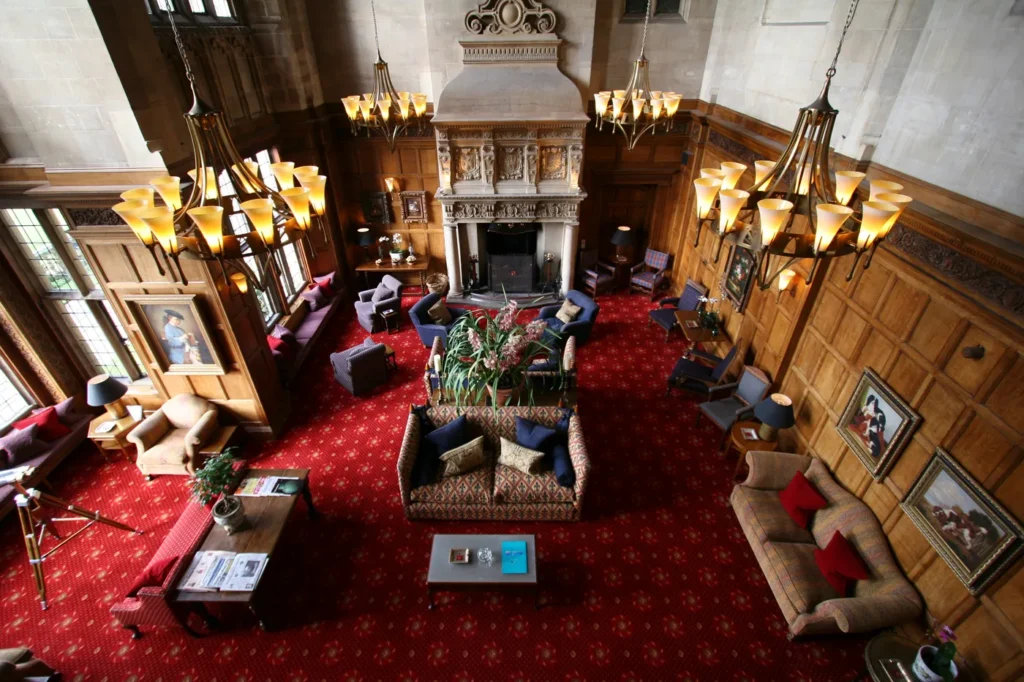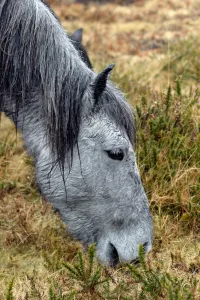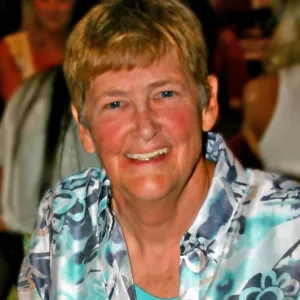England’s Bovey Castle
As our train from London trundled southwest to Devon, the countryside had a fresh-washed look, vibrant green accented with hardy yellow daffodils. We were taking a chance, visiting England in March. It had been raining. It could rain more.

And it did. A lot. However, it is the most fun we’ve ever had on a rained-out trip, and is way ahead of many with flawless weather. The success (i.e., the enjoyment) of a trip almost always hinges on the people we meet, as much as physical surroundings, activities or food and drink.
The driver who collected us at the station started things off right. For the past 20 years, David has spent a lot of time exploring the Dartmoor National Park–368 square miles of wild, boggy moorland surrounding Bovey Castle. I plied him with questions
as he drove the narrow, winding road from Exeter to Bovey. The moors—and Bovey Castle—were in the 1930s movie “The Hound of the Baskervilles,” a personal favorite of mine. I was anxious to see everything, and the passing scene provided a good build-up–exquisite stone cottages, centuries-old villages, and stone walls ringing fields dotted with sheep and cattle.
When the iron gates parted to let our vehicle into the hotel courtyard, I was struck by the fact that Bovey does not look like a castle–not in the traditional sense, with soaring turrets and a moat and such. It is actually a grand stone manor house, but with more than enough gargoyles and architectural flourishes to satisfy my castle cravings.
Built in 1906, the building and the estate had fallen on hard times before British entrepreneur Peter de Savary bought it in 2003. PDeS, as employees and friends call him, is a passionate fellow who rolls up his sleeves and throws himself into projects, insisting that relics be saved and that every detail be just right. Bovey Castle is a tribute to that. Without losing its turn-of-the-century feel, it has become a five-star resort with 65 elegantly restored guest rooms, a spa, a sensational indoor pool, an equestrian center, a small conference center, a golf clubhouse and 23 private stone lodges. The style is Art Deco, evocative of the early 1920s when Bovey was in its glory.

PDeS’s diligence is obvious throughout the grounds. As Chris takes us on a tour, he points out gardens, statues and fountains that have resurrected, along with a low-slung shed where apple cider and sloe gin are made from ingredients gathered on the estate, just as they were 100 years ago. We linger there, sampling the sloe gin while waiting for the rain to slacken. The pistol-shooting and archery ranges are nearby, and Chris tells us the two sports are very popular with groups because men and women can compete on equal terms.
The greatest restoration on the grounds is the golf course, built in the 1930s as a sister track to Scotland’s Turnberry and Gleneagles courses. PDeS engaged Donald Steel and Tom Mackenzie for the makeover, which involved new irrigation and drainage and tweaking the distances to make it more testing for today’s golfer. The 2006 Euro-Pro Tour played here, and was suitably impressed.
The first eight holes are entwined with the Bowden and Bovey rivers—fast-flowing trout streams lined with centuries-old oaks and patches of wildflowers. Distance is not often a factor on the 6,303-yard par 70, but accuracy always is. The second hole, for instance, is a left dogleg around woods. It’s easy to overshoot the fairway on this 382-yard par 4, and it’s critical to hug the left side to set up the approach over running water to a modest green. Water also dominates the third hole, a 208-yard par 3 almost completely surrounded by a river and lake.
Rain fell on the golf course, the turf squished under our feet, the streams were swollen with runoff, and we shivered in what locals said was an unusually cold spring. All of which made the castle more inviting when we shed our slickers and “brolies” in the simple hotel vestibule, which resembled our “mud room” at home. A few steps into the heart of the place, nothing resembled our modern home. Warmth poured from fireplaces in the Cathedral Room, the Adam Room and the Oak Room and Piano Bar. We sank into deep chairs at the bar, where barmen Alberto and Lauris recommended the De Savary Victory, champagne with fresh pink grapefruit juice and a touch of peach schnapps. Suitably fortified, we made our way to the spa for a swim in the lovely indoor pool, followed by a long massage.
The Art Deco look plays out beautifully in the Palm Court, the main dining room, with its walls of hand-painted silk and big windows overlooking the Grand Terrace. Chef James O’Connor oversees a menu that changes daily to reflect fresh produce on hand. Suffice it to say, the food, wines and service matched the setting, with sublime local beef, lamb and fish.

Our room had a view of the moors in the distance, and when I cranked open the leaded window, it seemed that the fog would come right into the room, carrying the ghost of that infamous hound. We explored the spooky moors on two separate days, lowering car windows to gaze at wild ponies, sheep, and hardy hikers caught in the mist. Venturing into the steady rain, we examined stone remnants of prehistoric villages, sites that have remained undisturbed in this inhospitable land. Our guide explained to us that even on a beautiful day the mist could roll in, stranding hikers. The bogs bordering the narrow paths can be treacherous, with innocent-looking patches that are actually quicksand. Nevertheless, the park is popular with kite fliers, cross-country runners, bikers and walkers. I vowed to return when the heather and gorse are in bloom, apparently a glorious sight.
We came upon a tavern in the middle of nowhere that seemed to float in the fog like a mirage. It has no electricity or plumbing, but the fire on the hearth has been burning continuously for 200 years, warming countless lost hikers.
The rain slacked in time for us to enjoy the daily falconry demonstration conducted by Martin, a highly entertaining fellow who takes his birds—and guests—hunting on the moors when weather permits. We’d gotten used to the rain, so we donned slickers and “wellies” (high rubber Wellington boots) to follow a dripping forest path to the village of North Bovey, and the 13-century thatch-roofed Ring of Bells Inn, just off the village green. The beer was cold, the fire warm, and the reception even warmer from the innkeepers and their dog.
Walking back to the castle, the thought occurred to me, who needs sun? Despite the cold rain and gloom, everyone we’d met had been cheery and genuinely enthusiastic about the place where they live, work and play. No one complained about the weather!
We must return sometime when it’s not raining, just to see how good it can get.
Bovey Castle
Devon, England
011 44 (0) 1647 445 000
www.boveycastle.co
Tags:
About Dale

In the course of her life, she has exercised racehorses at New York's Belmont Park, shown jumping horses on the A Circuit, driven a race car with the late Paul Newman, and played the world's most famous golf courses. She is a former private pilot and an avid scuba diver. Read More...

In the course of her life, she has exercised racehorses at New York's Belmont Park, shown jumping horses on the A Circuit, driven a race car with the late Paul Newman, and played the world's most famous golf courses. She is a former private pilot and an avid scuba diver. Read More...
